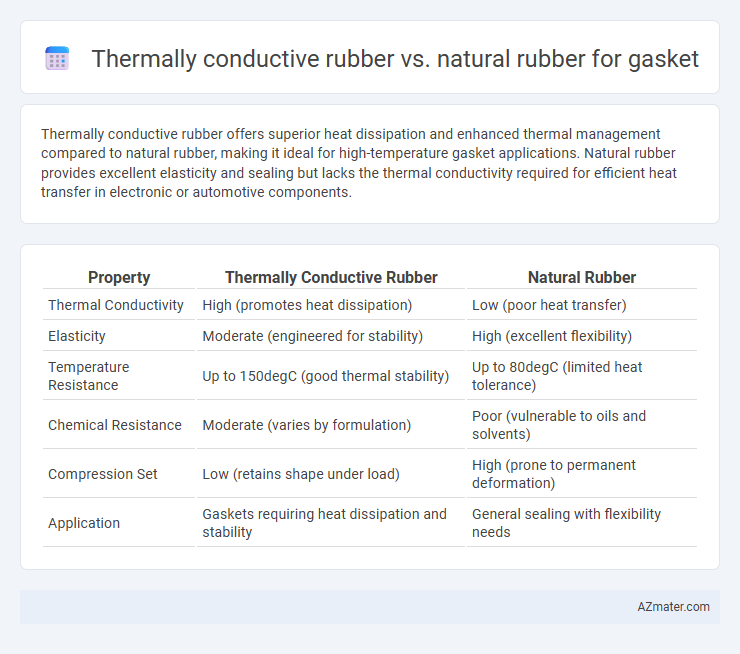Thermally conductive rubber offers superior heat dissipation and enhanced thermal management compared to natural rubber, making it ideal for high-temperature gasket applications. Natural rubber provides excellent elasticity and sealing but lacks the thermal conductivity required for efficient heat transfer in electronic or automotive components.
Table of Comparison
| Property | Thermally Conductive Rubber | Natural Rubber |
|---|---|---|
| Thermal Conductivity | High (promotes heat dissipation) | Low (poor heat transfer) |
| Elasticity | Moderate (engineered for stability) | High (excellent flexibility) |
| Temperature Resistance | Up to 150degC (good thermal stability) | Up to 80degC (limited heat tolerance) |
| Chemical Resistance | Moderate (varies by formulation) | Poor (vulnerable to oils and solvents) |
| Compression Set | Low (retains shape under load) | High (prone to permanent deformation) |
| Application | Gaskets requiring heat dissipation and stability | General sealing with flexibility needs |
Introduction to Rubber Gaskets
Rubber gaskets serve as critical sealing components in various industrial applications, preventing leaks and maintaining pressure. Thermally conductive rubber gaskets offer enhanced heat dissipation properties, essential for electronics and automotive industries, while natural rubber gaskets provide excellent elasticity and chemical resistance ideal for general sealing needs. Selecting between thermally conductive and natural rubber gaskets depends on specific thermal management requirements and environmental exposure.
Overview of Thermally Conductive Rubber
Thermally conductive rubber offers enhanced heat dissipation properties compared to natural rubber, making it ideal for gasket applications in electronic devices and automotive industries where temperature regulation is critical. Its composite materials, often infused with ceramic or metal fillers, provide superior thermal conductivity while maintaining flexibility and resilience. This advanced material ensures improved thermal management, durability, and sealing performance under high-temperature conditions.
Properties of Natural Rubber
Natural rubber offers excellent elasticity, resilience, and vibration damping, making it an ideal gasket material for applications requiring flexibility and sealing under dynamic conditions. Its high tensile strength and abrasion resistance enhance durability, while natural rubber's inherent resistance to water and certain solvents ensures reliable performance in various industrial environments. Compared to thermally conductive rubber, natural rubber lacks enhanced heat dissipation properties but excels in mechanical sealing and flexibility for moderate temperature ranges.
Thermal Conductivity Comparison
Thermally conductive rubber exhibits significantly higher thermal conductivity, typically ranging from 1 to 10 W/m*K, compared to natural rubber's low thermal conductivity of approximately 0.13 W/m*K, making it ideal for efficient heat dissipation in gasket applications. Enhanced thermal management provided by thermally conductive rubber minimizes thermal resistance and improves the performance and longevity of electronic devices or machinery. Natural rubber offers excellent elasticity and chemical resistance but is less effective in applications requiring rapid heat transfer or temperature regulation.
Mechanical Strength and Durability
Thermally conductive rubber offers superior mechanical strength and enhanced durability compared to natural rubber, making it ideal for gasket applications subjected to high thermal and mechanical stress. Its reinforced polymer matrix improves resistance to compression set, wear, and aging, ensuring longer service life and consistent performance under fluctuating temperatures. Natural rubber gaskets, while flexible and cost-effective, tend to degrade faster under extreme conditions and exhibit lower tensile strength and tear resistance.
Chemical and Environmental Resistance
Thermally conductive rubber offers superior chemical resistance compared to natural rubber, effectively withstanding oils, solvents, and various industrial chemicals without degradation. Its enhanced resistance to environmental factors such as UV radiation, ozone, and temperature fluctuations extends gasket lifespan in harsh conditions. Natural rubber, while flexible and resilient, tends to degrade faster when exposed to harsh chemicals and environmental stressors, limiting its suitability for demanding gasket applications.
Applications in Industrial Settings
Thermally conductive rubber offers superior heat dissipation and electrical insulation, making it ideal for gaskets in electronics, automotive, and heavy machinery industries where thermal management is critical. Natural rubber, prized for its elasticity and chemical resistance, suits applications requiring flexible sealing in less thermally demanding environments such as food processing and general manufacturing. In industrial settings, thermally conductive rubber gaskets enhance equipment longevity by preventing overheating, while natural rubber gaskets provide reliable sealing in dynamic or chemically exposed conditions.
Cost and Availability
Thermally conductive rubber for gaskets typically costs more due to specialized fillers like graphene or boron nitride, enhancing heat dissipation but increasing production expenses. Natural rubber offers a cost-effective and widely available alternative, commonly sourced from renewable latex, making it economical for large-scale applications. However, natural rubber lacks the enhanced thermal conductivity necessary for high-heat environments, limiting its use where heat management is critical.
Installation and Maintenance Considerations
Thermally conductive rubber gaskets offer enhanced heat dissipation properties, making them ideal for applications with significant thermal cycling, which reduces the risk of gasket failure during installation and operation. Natural rubber gaskets provide excellent elasticity and ease of installation but may require more frequent maintenance due to lower thermal stability and susceptibility to degradation under high temperatures. Choosing thermally conductive rubber minimizes maintenance needs and improves gasket longevity in environments where effective heat transfer and durability are critical.
Choosing the Right Rubber for Your Gasket Needs
Thermally conductive rubber offers superior heat dissipation properties essential for gaskets in electronics and automotive applications, ensuring efficient thermal management and preventing overheating. Natural rubber provides excellent elasticity, chemical resistance, and affordability, making it suitable for general-purpose gaskets exposed to moderate temperatures and standard environmental conditions. Selecting the right rubber depends on the application's thermal requirements, mechanical stress, and environmental exposure to balance performance and cost effectively.

Infographic: Thermally conductive rubber vs Natural rubber for Gasket
 azmater.com
azmater.com